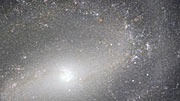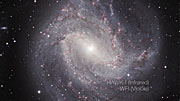Komunikat prasowy
Clear New View of a Classic Spiral
19 maja 2010

Acknowledgement: Mischa Schirmer)
ESO is releasing a beautiful image of the nearby galaxy Messier 83 taken by the HAWK-I instrument on ESO’s Very Large Telescope (VLT) at the Paranal Observatory in Chile. The picture shows the galaxy in infrared light and demonstrates the impressive power of the camera to create one of the sharpest and most detailed pictures of Messier 83 ever taken from the ground.
The galaxy Messier 83 (eso0825) is located about 15 million light-years away in the constellation of Hydra (the Sea Serpent). It spans over 40 000 light-years, only 40 percent the size of the Milky Way, but in many ways is quite similar to our home galaxy, both in its spiral shape and the presence of a bar of stars across its centre. Messier 83 is famous among astronomers for its many supernovae: vast explosions that end the lives of some stars. Over the last century, six supernovae have been observed in Messier 83 — a record number that is matched by only one other galaxy. Even without supernovae, Messier 83 is one of the brightest nearby galaxies, visible using just binoculars.
Messier 83 has been observed in the infrared part of the spectrum using HAWK-I [1], a powerful camera on ESO’s Very Large Telescope (VLT). When viewed in infrared light most of the obscuring dust that hides much of Messier 83 becomes transparent. The brightly lit gas around hot young stars in the spiral arms is also less prominent in infrared pictures. As a result much more of the structure of the galaxy and the vast hordes of its constituent stars can be seen. This clear view is important for astronomers looking for clusters of young stars, especially those hidden in dusty regions of the galaxy. Studying such star clusters was one of the main scientific goals of these observations [2]. When compared to earlier images, the acute vision of HAWK-I reveals far more stars within the galaxy.
The combination of the huge mirror of the VLT, the large field of view and great sensitivity of the camera, and the superb observing conditions at ESO’s Paranal Observatory makes HAWK-I one of the most powerful near-infrared imagers in the world. Astronomers are eagerly queuing up for the chance to use the camera, which began operation in 2007 (eso0736), and to get some of the best ground-based infrared images ever of the night sky.
Uwagi
[1] HAWK-I stands for High-Acuity Wide-field K-band Imager. More technical details about the camera can be found in an earlier press release (eso0736).
[2] The data used to prepare this image were acquired by a team led by Mark Gieles (University of Cambridge) and Yuri Beletsky (ESO). Mischa Schirmer (University of Bonn) performed the challenging data processing.
Więcej informacji
ESO, the European Southern Observatory, is the foremost intergovernmental astronomy organisation in Europe and the world’s most productive astronomical observatory. It is supported by 14 countries: Austria, Belgium, Czechia, Denmark, France, Finland, Germany, Italy, the Netherlands, Portugal, Spain, Sweden, Switzerland and the United Kingdom. ESO carries out an ambitious programme focused on the design, construction and operation of powerful ground-based observing facilities enabling astronomers to make important scientific discoveries. ESO also plays a leading role in promoting and organising cooperation in astronomical research. ESO operates three unique world-class observing sites in Chile: La Silla, Paranal and Chajnantor. At Paranal, ESO operates the Very Large Telescope, the world’s most advanced visible-light astronomical observatory and VISTA, the world’s largest survey telescope. ESO is the European partner of a revolutionary astronomical telescope ALMA, the largest astronomical project in existence. ESO is currently planning a 42-metre European Extremely Large optical/near-infrared Telescope, the E-ELT, which will become “the world’s biggest eye on the sky”.
Kontakt
Richard Hook
ESO
Garching, Germany
Tel.: +49 89 3200 6655
E-mail: rhook@eso.org
O komunikacie
| Komunikat nr: | eso1020 |
| Nazwa: | M 83 |
| Typ: | Local Universe : Galaxy : Type : Spiral |
| Facility: | Very Large Telescope |
| Instrumenty: | HAWK-I |
Our use of Cookies
We use cookies that are essential for accessing our websites and using our services. We also use cookies to analyse, measure and improve our websites’ performance, to enable content sharing via social media and to display media content hosted on third-party platforms.
ESO Cookies Policy
The European Organisation for Astronomical Research in the Southern Hemisphere (ESO) is the pre-eminent intergovernmental science and technology organisation in astronomy. It carries out an ambitious programme focused on the design, construction and operation of powerful ground-based observing facilities for astronomy.
This Cookies Policy is intended to provide clarity by outlining the cookies used on the ESO public websites, their functions, the options you have for controlling them, and the ways you can contact us for additional details.
What are cookies?
Cookies are small pieces of data stored on your device by websites you visit. They serve various purposes, such as remembering login credentials and preferences and enhance your browsing experience.
Categories of cookies we use
Essential cookies (always active): These cookies are strictly necessary for the proper functioning of our website. Without these cookies, the website cannot operate correctly, and certain services, such as logging in or accessing secure areas, may not be available; because they are essential for the website’s operation, they cannot be disabled.
Functional Cookies: These cookies enhance your browsing experience by enabling additional features and personalization, such as remembering your preferences and settings. While not strictly necessary for the website to function, they improve usability and convenience; these cookies are only placed if you provide your consent.
Analytics cookies: These cookies collect information about how visitors interact with our website, such as which pages are visited most often and how users navigate the site. This data helps us improve website performance, optimize content, and enhance the user experience; these cookies are only placed if you provide your consent. We use the following analytics cookies.
Matomo Cookies:
This website uses Matomo (formerly Piwik), an open source software which enables the statistical analysis of website visits. Matomo uses cookies (text files) which are saved on your computer and which allow us to analyze how you use our website. The website user information generated by the cookies will only be saved on the servers of our IT Department. We use this information to analyze www.eso.org visits and to prepare reports on website activities. These data will not be disclosed to third parties.
On behalf of ESO, Matomo will use this information for the purpose of evaluating your use of the website, compiling reports on website activity and providing other services relating to website activity and internet usage.
Matomo cookies settings:
Additional Third-party cookies on ESO websites: some of our pages display content from external providers, e.g. YouTube.
Such third-party services are outside of ESO control and may, at any time, change their terms of service, use of cookies, etc.
YouTube: Some videos on the ESO website are embedded from ESO’s official YouTube channel. We have enabled YouTube’s privacy-enhanced mode, meaning that no cookies are set unless the user actively clicks on the video to play it. Additionally, in this mode, YouTube does not store any personally identifiable cookie data for embedded video playbacks. For more details, please refer to YouTube’s embedding videos information page.
Cookies can also be classified based on the following elements.
Regarding the domain, there are:
- First-party cookies, set by the website you are currently visiting. They are stored by the same domain that you are browsing and are used to enhance your experience on that site;
- Third-party cookies, set by a domain other than the one you are currently visiting.
As for their duration, cookies can be:
- Browser-session cookies, which are deleted when the user closes the browser;
- Stored cookies, which stay on the user's device for a predetermined period of time.
How to manage cookies
Cookie settings: You can modify your cookie choices for the ESO webpages at any time by clicking on the link Cookie settings at the bottom of any page.
In your browser: If you wish to delete cookies or instruct your browser to delete or block cookies by default, please visit the help pages of your browser:
Please be aware that if you delete or decline cookies, certain functionalities of our website may be not be available and your browsing experience may be affected.
You can set most browsers to prevent any cookies being placed on your device, but you may then have to manually adjust some preferences every time you visit a site/page. And some services and functionalities may not work properly at all (e.g. profile logging-in, shop check out).
Updates to the ESO Cookies Policy
The ESO Cookies Policy may be subject to future updates, which will be made available on this page.
Additional information
For any queries related to cookies, please contact: pdprATesoDOTorg.
As ESO public webpages are managed by our Department of Communication, your questions will be dealt with the support of the said Department.






